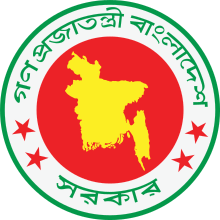Socialism in Bangladesh
Socialism is one of the four fundamental principles according to the original Constitution of Bangladesh.[1][2] Socialism in Bangladesh differs from socialist countries where all the means of production are owned socially. Socialism has been considered in the Constitution as a way to establish an exploitation-free society.[3][4] The constitution allows cooperative and private ownership along with state ownership.[5][6]
 |
|---|
| This article is part of a series on the politics and government of Bangladesh |
|
Constitution and law
|
|
Government |
|
|
|
|
|
History
After the liberation of Bangladesh in 1971, some socialistic approaches were taken by the Government of Bangladesh, increasing state participation in the productive activities to improve the economic status of the war ridden country. With a view to establishing a socialist nation, many large and medium-sized enterprises and public utility enterprises were nationalized.[7][8] On 26 March 1972, all banks, and all insurance companies excluding the branches of foreign banks were nationalized.[9] The reformation process left only the small and cottage industries for the private sector.[8]
Although public sector expanded very rapidly, the share of public sector in GDP and in total productive efforts was insignificant.[10] This was because the agricultural sector was left to the private sector, which comprised about 80% of the national economy.[11]
On 24 February 1975, Sheikh Mujibur Rahman used the powers granted to him by the fourth amendment of the constitution to form a new political party, Bangladesh Krishak Sramik Awami League (BAKSAL). It would be the only party allowed in Parliament.[12] All other political parties were outlawed with the formation of BAKSAL through a presidential order.[13] The party advocated state socialism as a part of the group of reforms under the theory of Second Revolution.[14] BAKSAL was the decision making council to achieve the objectives of the Second Revolution.[15] With the assassination of Sheikh Mujib in 1975, BAKSAL was dissolved.
During the years of military rule that followed under Ziaur Rahman (1975-1981) and Hussain Muhammad Ershad (1982-1990), socialist policies and rhetoric were abandoned. State enterprises were dismantled, state subsidies withdrawn and trade liberalization and exports promoted. Thus, contemporary Bangladesh has among the most liberalized economies of South Asia.[16]
References
- THE CONSTITUTION. "8.Fundamental principles". bdlaws.minlaw.gov.bd. PEOPLE’S REPUBLIC OF BANGLADESH. Retrieved 25 April 2017.
- Mercan, Muhammed Hüseyin (8 March 2016). Transformation of the Muslim World in the 21st Century. Cambridge Scholars Publishing. p. 157. ISBN 9781443890007.
- "10. Socialism and freedom from exploitation". bdlaws.minlaw.gov.bd. Retrieved 25 April 2017.
- Phillips, Douglas A.; Gritzner, Charles F. (1 January 2007). Bangladesh. Infobase Publishing. p. 65. ISBN 9781438104850.
- Afzalur Rashid, Sudhir C. Lodh (1 January 2008). "The influence of ownership structures and board practices on corporate social disclosures in Bangladesh". Corporate Governance in Less Developed and Emerging Economies. Research in Accounting in Emerging Economies. Emerald Group Publishing Limited. 8: 211–237. doi:10.1016/s1479-3563(08)08008-0. ISBN 9781848552524.
- International Monetary Fund (25 June 2003). Bangladesh: Report on Observance of Standards and Codes-Fiscal Transparency. International Monetary Fund. p. 8. ISBN 9781451877182.
- Alam, S. M. Shamsul (29 April 2016). Governmentality and Counter-Hegemony in Bangladesh. Springer. ISBN 9781137526038.
- Ahamed, Emajuddin (1 January 1978). "Development Strategy in Bangladesh: Probable Political Consequences". Asian Survey. University of California Press. 18 (11): 1168–1180. doi:10.2307/2643299. JSTOR 2643299.
- Schottli, Jivanta; Mitra, Subrata K.; Wolf, Siegried (8 May 2015). A Political and Economic Dictionary of South Asia. Routledge. p. 4. ISBN 9781135355760.
- Hossain, Naomi (23 February 2017). The Aid Lab: Understanding Bangladesh's Unexpected Success. Oxford University Press. p. 40. ISBN 9780198785507.
- Planning Commission (November 1973). The First Five Year Plan (1973-78). Dacca: Government of the People's Republic of Bangladesh. pp. 48–49.
- Ahmed, Moudud (1984) [First published 1983]. Bangladesh: Era of Sheikh Mujibur Rahman. Wiesbaden: Franz Steiner Verlag. pp. 245, 247. ISBN 3-515-04266-0.
- Mitra, Subrata Kumar; Enskat, Mike; Spiess, Clemens (1 January 2004). Political Parties in South Asia. Greenwood Publishing Group. p. 226. ISBN 9780275968328.
- Mitra, Subrata Kumar; Enskat, Mike; Spiess, Clemens (1 January 2004). Political Parties in South Asia. Greenwood Publishing Group. p. 225. ISBN 9780275968328.
- "BANGLADESH: The Second Revolution". Time. 10 February 1975. ISSN 0040-781X. Retrieved 1 May 2017.
- Riaz, Ali; Fair, Christine, eds. (2010). "Political Culture in Contemporary Bangladesh". Political Islam and Governance in Bangladesh. Oxford: Routledge. p. 34. ISBN 978-113692-623-5.

